Nottingham One is notable for being one of the largest mixed-use developments delivered in the East Midlands in the past ten years. Concrete was selected at an early stage as the principal material for the development and offsite manufacture added a range of project benefits.
Containing 236 apartments (100 affordable) and 5,000m2 of commercial space, this £40 million mixed-use development is the product of a coherent and singular architectural response to the needs of the city and its individuals.
Much of this success is due to the robust, simple design concepts established at the outset, focusing on simplicity, standardisation and high-quality, self-finished materials. These include a post-tensioned concrete frame with a three-storey ‘tree’ that cantilevers the scheme’s tower over the city’s buried district heating pipework and a 160m long terrace building clad in a precast concrete façade. Further efficiencies include post-tensioned concrete slabs throughout (eliminating down-stand beams and simplifying service runs) and a high-quality, modular, precast concrete façade to the street, fabricated locally by Trent Concrete.
The precast used for cladding the building and balconies – Trent Concrete’s Portland mix – was chosen for its similarity to local Nottingham stone. From an aesthetic perspective, its use allowed for refined detailing, long spans and the formation of curves, both in plan and in elevation. On the façades, precast was used in a large-format, multi-storey panel form for external cladding. Rebated joints reflect the building’s structural grid and the module of apartments behind.
The use of precast concrete allowed for early cost certainty on a fundamental and strategic part of the project. High-quality material samples and the excellent reputation of precast as a finished product, assisted with the discharge of planning conditions in a Conservation Area. Very fine tolerance in precast works meant that windows and glazing, which were installed into precast apertures, could also be procured and fabricated offsite in parallel with the precast works. This substantially reduced the construction programme and reduced risk for the project.
All of the concrete, both in-situ and precast, was procured through a local supply chain, using batching plants and precast suppliers. This substantially reduced delivery journey times and allowed for efficient dispatch of precast units to site as and when required by the project programme.
Where possible, the concrete has been left exposed in the building, providing thermal mass, particularly in commercial spaces where it helps to moderate temperature fluctuations. Use of flat forms, with no down-stand beams in-situ works, allowed for very rapid construction. All the precast concrete was designed, cast and stored offsite, allowing for efficient deliveries when required.
Rapid installation – along a busy city centre road – minimised disruption to highways and pedestrians and contributed to a valuable sense of momentum in the project. All the formwork timber moulds for the precast components were made with FSC-certified timber. After multiple castings, these were either recycled for other moulds or chipped for use as biomass fuel to heat the works.
Nottingham One is an example of how high-density, urban housing can be provided in the city, hopefully inspiring other regional councils, housing associations, local developers and regeneration agencies to be equally ambitious. The development won a RIBA East Midlands Award 2016 and was shortlisted for the 2016 Building Awards.
For more information visit: www.levitate.uk.com
Source: Offsite Magazine - Issue 5









